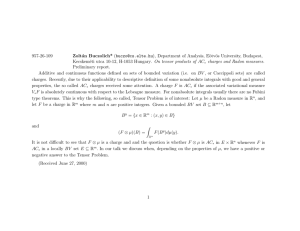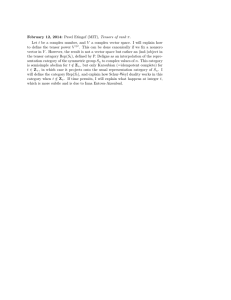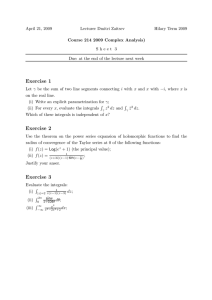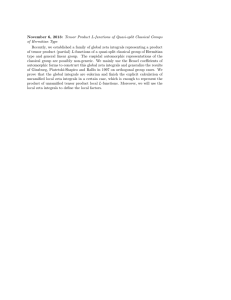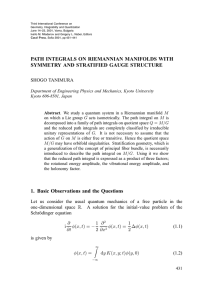A Recursive Scheme of First Integrals ld ?
advertisement
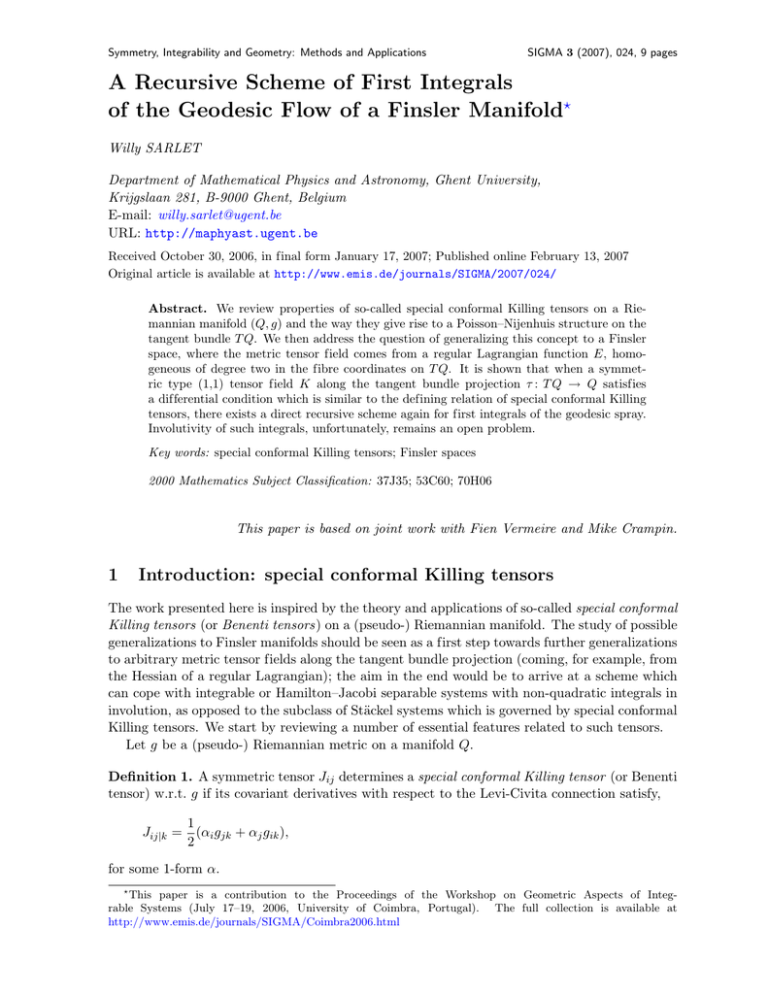
Symmetry, Integrability and Geometry: Methods and Applications
SIGMA 3 (2007), 024, 9 pages
A Recursive Scheme of First Integrals
of the Geodesic Flow of a Finsler Manifold?
Willy SARLET
Department of Mathematical Physics and Astronomy, Ghent University,
Krijgslaan 281, B-9000 Ghent, Belgium
E-mail: willy.sarlet@ugent.be
URL: http://maphyast.ugent.be
Received October 30, 2006, in final form January 17, 2007; Published online February 13, 2007
Original article is available at http://www.emis.de/journals/SIGMA/2007/024/
Abstract. We review properties of so-called special conformal Killing tensors on a Riemannian manifold (Q, g) and the way they give rise to a Poisson–Nijenhuis structure on the
tangent bundle T Q. We then address the question of generalizing this concept to a Finsler
space, where the metric tensor field comes from a regular Lagrangian function E, homogeneous of degree two in the fibre coordinates on T Q. It is shown that when a symmetric type (1,1) tensor field K along the tangent bundle projection τ : T Q → Q satisfies
a differential condition which is similar to the defining relation of special conformal Killing
tensors, there exists a direct recursive scheme again for first integrals of the geodesic spray.
Involutivity of such integrals, unfortunately, remains an open problem.
Key words: special conformal Killing tensors; Finsler spaces
2000 Mathematics Subject Classification: 37J35; 53C60; 70H06
This paper is based on joint work with Fien Vermeire and Mike Crampin.
1
Introduction: special conformal Killing tensors
The work presented here is inspired by the theory and applications of so-called special conformal
Killing tensors (or Benenti tensors) on a (pseudo-) Riemannian manifold. The study of possible
generalizations to Finsler manifolds should be seen as a first step towards further generalizations
to arbitrary metric tensor fields along the tangent bundle projection (coming, for example, from
the Hessian of a regular Lagrangian); the aim in the end would be to arrive at a scheme which
can cope with integrable or Hamilton–Jacobi separable systems with non-quadratic integrals in
involution, as opposed to the subclass of Stäckel systems which is governed by special conformal
Killing tensors. We start by reviewing a number of essential features related to such tensors.
Let g be a (pseudo-) Riemannian metric on a manifold Q.
Definition 1. A symmetric tensor Jij determines a special conformal Killing tensor (or Benenti
tensor) w.r.t. g if its covariant derivatives with respect to the Levi-Civita connection satisfy,
1
Jij|k = (αi gjk + αj gik ),
2
for some 1-form α.
?
This paper is a contribution to the Proceedings of the Workshop on Geometric Aspects of Integrable Systems (July 17–19, 2006, University of Coimbra, Portugal). The full collection is available at
http://www.emis.de/journals/SIGMA/Coimbra2006.html
2
W. Sarlet
It follows that
X
X
Jij|k =
αi gjk ,
ijk
ijk
i.e. J is a conformal Killing tensor. Further properties (referring to J as (1,1)-tensor: Jji =
g ik Jkj ) are that J is a conformal Killing tensor of gradient type,
α = df = d(tr J),
and has vanishing Nijenhuis torsion NJ , i.e.
[JX, JY ] + J 2 ([X, Y ]) − J([JX, Y ] + [X, JY ]) = 0
∀ X, Y ∈ X (Q).
Moreover, assuming J is non-singular, its cofactor tensor A:
A J = (det J)I
is itself a Killing tensor, so that F = (1/2)Aij (q)pi pj is a quadratic first integral of the system
with Hamiltonian H = (1/2)g ij (q)pi pj on T ∗ Q.
As said above, metrics admitting a special conformal Killing tensor determine a subclass
of Stäckel systems, i.e. orthogonal separable systems in the sense of Hamilton–Jacobi with n
quadratic integrals in involution. We briefly sketch how this works, beginning with the integrability structures on T ∗ Q and T ∗ Q × R, determined by J.
e the complete lift of J, which in coordinates is given by
On T ∗ Q, consider J,
!
k
k
∂J
∂
∂
∂J
∂
j
i
Je = Jji
⊗ dq j +
⊗ dpi + pk
−
⊗ dq j .
i
j
i
∂q
∂pj
∂q
∂q
∂pi
If ω = dθ denotes the standard symplectic structure and
ω1 = d(Jθ) = d(Jji pi dq j ),
we have that
iJ(X)
ω = iX ω1
e
∀ X ∈ X (T ∗ Q).
It follows that Je is symmetric with respect to ω. Moreover, we have dω1 = 0 obviously, and
NJe = 0 as a result of NJ = 0. These are the properties which are sufficient to ensure that
a special conformal Killing tensor J on (Q, g) determines a Poisson–Nijenhuis structure on T ∗ Q
with Je as recursion operator. In addition, we have the interesting relations
ddJeh = d(tr J) ∧ dh,
ddJe(tr J) = 0,
which give rise to an extension of the two compatible Poisson structures to T ∗ Q × R. Details
about all of this can be found in [3].
Observe that the special conformal Killing tensor J plays a kind of double role for the complete
integrability of H = (1/2)g ij pi pj . First of all, we have that J + sI is a special conformal Killing
tensor for all s, and thus gives rise to a family of corresponding Killing tensors A(s), and in this
way to a hierarchy of quadratic integrals. Secondly, the double Poisson structure created by J
truly helps to show that such integrals are in involution, in fact with respect to both brackets
(although other, more direct techniques for showing involutivity may sometimes be successful as
well, see e.g. [5]). Incidentally, the reference just cited also addresses another important aspect
of the integrals, namely their functional independence, for which it is shown to be enough that
First Integrals of the Geodesic Flow of a Finsler Manifold
3
the eigenvalues of J are different at one point. To complete the construction of Stäckel systems
then, one can proceed as follows. For a function V on Q to be an admissible potential, it is
necessary and sufficient that V satisfies
ddJeV = d(tr J) ∧ dV.
Admissibility of V means that
1
h = g ij pi pj + V
2
is still separable, and there are then suitable modifications of the first integrals of the kinetic
energy part which constitute an amended set of quadratic integrals in involution. To avoid
forgetting a number of interesting references concerning details and background about these
results, we limit ourselves to citing the excellent review paper [2] and refer to the list of references
therein.
2
A tangent bundle view of special conformal Killing tensors
We explain some of the results from [4] here; understanding a Lagrangian perspective of what
precedes is essential for the generalization to Finsler spaces we have in mind.
Let (Q, g) as before be a pseudo-Riemannian manifold and consider the function
1
L = gij (q)ui uj ∈ C ∞ (T Q).
2
Then, T Q becomes a symplectic manifold via the Poincaré–Cartan 2-form
ωL = dθL ,
with
θL = S(dL) =
∂L i
dq ,
∂ui
where S is the canonically defined ‘vertical endomorphism’ on T Q.
Consider then again a type (1,1) tensor field J on Q. The following is an interesting result
of [4]: it gives a concise, intrinsic characterization of special conformal Killing tensors, directly
in their type (1,1) appearance.
Theorem 1. J is a special conformal Killing tensor if and only if it is symmetric with respect
to g and satisfies the following relation for some function f ∈ C ∞ (Q):
1
∇J = (T ⊗ dHf − Xf ⊗ θL ).
2
(1)
Obviously, we have a bit of work to do here to explain the symbols in this formulation.
In principle, this whole formula is about tensor fields along the tangent bundle projection
τ : T Q → Q, though some of its ingredients so far happen to live on the base manifold Q.
The operations which are being used rely on the (non-linear) connection associated to a given
second-order field Γ (here coming from the Euler–Lagrange equations of L). If we express the
coordinate representation of a general second-order field Γ as
Γ = ui
∂
∂
+ F i (q, u) i ,
i
∂q
∂u
then the basis of horizontal vector fields Hi on T Q, defining the connection, is given by
Hi =
∂
∂
− Γji (q, u) j ,
i
∂q
∂u
with
Γji = −
1 ∂F j
.
2 ∂ui
4
W. Sarlet
We have
dH f = Hi (f )dq i
and
Xf g = −dHf.
T is the canonical vector field along τ (essentially the identity map on T Q), given by
T = ui
∂
,
∂q i
and ∇, finally, is the dynamical covariant derivative operator. It acts like Γ on functions on T Q,
and is further determined by ∇(∂/∂q i ) = Γji ∂/∂q j and by duality on dq j . Up to now, however,
f and J live on Q, so that in fact dH f = df and, taking into account that we are in a situation
i uk . Observe that it easily follows from (1), by taking
where Γji = Γjik (q)uk , we have (∇J)ij = Jj|k
a trace, that f = tr J.
If J is an arbitrary (1,1) tensor on Q, its vertical lift J V defines a kind of alternative almost
tangent structure on T Q, at least we have J V 2 = 0 and NJ V = 0. Therefore, it is a natural
construction to let J V take over the role of S for the purpose of defining a second 2-form and
the subsequent construction of a type (1,1) tensor R on T Q. In other words, natural tangent
bundle constructions lead us to define R on T Q by
iR(X) d(S(dL)) = iX d(J V (dL))
∀ X ∈ X (T Q),
(2)
and if NJ = 0 on Q (as in the case of a special conformal Killing tensor), we have NR = 0 on T Q
as well, so that R becomes the recursion operator of a Poisson–Nijenhuis structure on T Q. In
fact, R is precisely the pullback of Je under the Legendre transform associated to the given
regular Lagrangian L.
3
Generalization: Finsler manifolds
Let (Q, E) now be a Finsler space, that is to say, E : T Q → R is the square of a Finsler
function F , is homogeneous of degree two in the ui (E(0) = 0), and ωE = dθE is non-degenerate
on the slit tangent bundle T Q \ {0}.
Putting
gij (q, u) =
∂2E
,
∂ui ∂uj
we have a (0,2) tensor field along the tangent bundle projection τ , and consider its canonical spray Γ on T Q \ {0} (i.e. the Euler–Lagrange equations of E). Note that in view of the
homogeneity,
1
1
E = g(T, T) = gij ui uj ,
2
2
and we also have
∇g = 0,
∇T = 0.
It is then easy to deduce the following additional properties:
∇E = Γ(E) = 0,
dH E = 0,
θE = T g,
∇θE = 0.
It may be worthwhile to make the following preliminary remark to avoid confusion. There is
often a lively debate in Finsler geometry about the selection of the best possible linear connection
First Integrals of the Geodesic Flow of a Finsler Manifold
5
to replace the Levi-Civita connection of Riemannian geometry. Most of the time, about four
different possibilities are considered (see e.g. [1]), depending on whether one wants the connection
to be as metrical as possible, or whether one wants to eliminate as much torsion as possible.
We do not need to enter into this debate here, because all we need for deriving our main
results in this section is the dynamical covariant derivative operator ∇, as it was specified in
the preceding section: it comes from the non-linear connection associated to any second-order
differential equation field and acts on the full algebra of tensor fields along the tangent bundle
projection τ .
Inspired by the theorem of the preceding section, assume now that we have a type (1,1)
tensor K along τ , which is symmetric with respect to g, i.e. g(KX, Y ) = g(X, KY ), and satisfies
a relation of the form
1
∇K = (T ⊗ α − Xα ⊗ θE ),
2
(3)
for some 1-form α along τ , and with Xα defined by Xα g = −α. It would be quite natural
within this Finsler environment to assume that K is homogeneous of degree zero as well, but as
we will show now, such an extra assumption is not even required to arrive at a quite remarkable
hierarchy of first integrals for the canonical spray Γ.
An immediate consequence of (3), which follows from taking a trace, is that
α(T) = ∇ tr K.
As a result, if we put
h0 = k0 = E,
1
k1 = g(T, KT),
2
it is easy to show that also
h1 = k1 − E tr K
is a first integral. This is the start for the hierarchy of first integrals, for which we found the
following explicit recursive scheme. Define
1
kj = g(T, K j T),
2
and
aj =
1
tr K j ,
j
j = 1, 2, . . . .
Lemma 1. From the fundamental assumption (3) on K, it follows that
∇aj = α(K j T),
∇kj =
j
X
(∇ai )kj−i .
(4)
(5)
i=1
Proof . It is easy to show by induction that (3) implies that
∇K
j+1
j
1 X i
=
(K α ⊗ K j−i T − K i θE ⊗ K j−i Xα ).
2
i=0
Taking a trace, (4) immediately follows. Moreover, since
1
∇kj = g(T, ∇K j (T)),
2
a direct computation, using the formula for ∇K j just derived, leads to (5).
6
W. Sarlet
Next, we introduce auxiliary functions φk , defined recursively by
φ1 = 0,
φk =
k−1
k−1
1X
1X
ai ak−i −
(k − i)φi ak−i ,
2
k
i=1
Lemma 2. We have ∇φj =
k ≥ 2.
(6)
i=2
j−1
P
al ∇aj−l −
j−1
P
φl ∇aj−l ,
j ≥ 2.
l=2
l=1
Proof . From φ2 = (1/2)a21 , we get ∇φ2 = a1 ∇a1 and the property is clearly true for j = 2.
Assume it is valid for all j up to k − 1 and now act with ∇ on φk as defined by (6). We get
k−1
X
∇φk =
ai ∇ak−i −
i=1
+
1
k
k−1
k−1
i−1
X
1X
1X
(k − i)φi ∇ak−i −
(k − i)ak−i
al ∇ai−l
k
k
i=2
k−1
X
(k − i)ak−i
i=2
i−1
X
i=2
l=1
φl ∇ai−l .
l=2
In order to collect coefficients of ∇aj , we put j = k−i in the second term on the right and j = i−l
in the last two terms (and adjust the summations). Moreover, we subsequently interchange the
two summations in those last two terms and split off one term to have the common upper bound
k − 3 for j. The result reads
k−1
X
∇φk =
ai ∇ak−i −
k−2
1X
j φk−j ∇aj
k
j=1
i=1
k−3
1X
∇aj
−
k
j=1
k−1
X
k−1
X
(k − i)ak−i ai−j −
i=j+1
!
(k − i)ak−i φi−j
i=j+2
−
1 2
a ∇ak−2 .
k 1
In the terms between brackets, we now change i − j to l, thus getting
k−j−1
X
(k − j − l)ak−j−l al −
k−j−1
X
l=1
!
(k − j − l)ak−j−l φl
l=2
which upon closer inspection can be seen to be equal to (k − j)φk−j . It is now a matter of
splitting off the term for j = k − 2 in the second sum on the right also, to see a few cancellations
presenting themselves, which then readily produce the desired result.
Finally, put bk = φk − ak and define
hl = kl +
l
X
bi kl−i ,
l ≥ 1.
i=1
Theorem 2. Let K be a type (1, 1) tensor along τ : T Q → Q, which is symmetric with respect
to the Finsler metric g and satisf ies condition (3) for some α. Then the functions hl are f irst
integrals of the geodesic spray of the Finsler metric g, for all l.
Proof . From Lemma 1 we have, using also ∇k0 = 0,
∇hl =
l
X
i=1
(∇φi )kl−i +
l−1
X
i=1
bi
l−i
X
j=1
(∇aj )kl−i−j .
First Integrals of the Geodesic Flow of a Finsler Manifold
7
Putting m = i + j in the second term and interchanging the double summation, this becomes
!
l
i−1
X
X
∇hl =
(∇φi ) +
bm (∇ai−m ) kl−i + (∇φ1 )kl−1 .
m=1
i=2
This is clearly zero in view of φ1 = 0 and Lemma 2.
It is interesting to verify that one can rewrite the recursive formula for integrals in the
following alternative way:
1
hl = g(T, Bl T)
2
with
Bl = bl I + Bl−1 K,
B0 = I.
(7)
Moreover, the bl turn out to be the coefficients of the characteristic polynomial of K: indeed,
if n is the dimension of Q, one can show that
det(λ I − K) =
n
X
bi λn−i
(b0 = 1),
(8)
i=0
which means that in particular bn = (−1)n det K.
Obviously, this whole construction applies in particular to the Riemannian case with the
assumption that K is a special conformal Killing tensor on Q; in fact, the expression (7) looks
like a direct generalization of a result of Benenti (see the first theorem in section 7 of [2]).
The parallel with the Riemannian case goes further, in the sense that, if K is assumed to be
non-singular, there is again a first integral associated to the cofactor tensor. Observe, by the
way, that the quadratic integral F = (1/2)Aij (q)pi pj referred to in section 1 for the Riemannian
case, can be written in a tangent bundle set-up in the coordinate free format F = (1/2)g(AT, T),
and this statement happens to extend to the Finslerian situation.
Theorem 3. Let g be a Finsler metric, and K a symmetric (1, 1) tensor satisfying condition (3).
Then, if K is non-singular and A is its cofactor tensor, the function g(AT, T) is a f irst integral
of the geodesic spray.
Proof . We have that ∇A = ∇(det K)K −1 − (det K)K −1 ∇K K −1 and it is a general property
for derivation of degree zero such as ∇ that ∇ log(det K) = tr(K −1 ∇K). It follows that
∇(g(AT, T)) = g(∇A(T)T )
= (det K)(tr(K −1 ∇K)g(K −1 T, T) − g(∇KK −1 (T), K −1 (T))).
From the assumption (3) on K, it readily follows that tr(K −1 ∇K) = α(K −1 (T)) and
g(∇K K −1 (T), K −1 (T)) = α(K −1 (T))g(T, K −1 T).
Hence, ∇(g(AT, T)) = 0.
The hierarchy of first integrals derived above can now be established via the cofactor technique as well. Indeed, if K satisfies the fundamental condition (3), then so does K + sI for
n−1
P
Aj+1 sj therefore also gives rise to a hierarchy of first
all real values s. Its cofactor A(s) =
j=0
integrals.
In fact, we have
(K + sI)A(s) =
n−1
X
j=0
KAj+1 sj +
n
X
j=1
Aj sj .
8
W. Sarlet
On the other hand, using (8) we get
n
det(K + sI) = (−1) det((−s)I − K) =
n
X
(−1)i bi sn−i .
i=0
It follows that
An = I,
and
KA1 = (−1)n bn I,
which shows that A1 = A, while the other coefficients in the expansion of A(s) have to satisfy
the recursive relation
KAj+1 + Aj = (−1)n−j bn−j I,
j = 1, . . . , n − 1.
Going down this scheme from top to bottom, it is easy to see that An−j = (−1)j Bj , which shows
(see (7)) that the coefficients in the expansion of A(s) determine the same first integrals hl up
to sign. Notice that, in particular, A = A1 = (−1)n−1 Bn−1 , from which it follows that
Bn = Bn−1 K + bn I = (−1)n−1 AK + (−1)n (det K)I = 0.
One can verify also that bn+1 ≡ 0. Hence, the sequence of first integrals actually terminates
with hn = 0 and the cofactor tensor A of K determines the last non-zero integral hn−1 in the
hierarchy.
4
The problem of involutivity
We have not succeeded in coming anywhere near to proving that the integrals we obtained in
the previous section would be in involution with respect to the Poisson bracket associated to the
symplectic form dωE . One would expect to have better chances if one could use the tensor K
for constructing a recursion tensor R of a Poisson–Nijenhuis structure on T Q, just as in the
Riemannian case. Observe that the construction (2) of R in the Riemannian case in fact makes
sense under much more general circumstances. Indeed, the vertical lift J V remains well defined
if we replace the basic tensor J on Q by a tensor J along the projection τ , and the function L can
be taken to be any regular Lagrangian on a tangent bundle T Q. Such an R then is determined,
through its action on vertical and horizontal lifts of vector fields X along τ , by formulas of the
form (see [6])
V
R(X V ) = (KX) ,
R(X H ) = (KX)H + (U X)V ,
where K is the transpose of K (with respect to g) and K and U are defined by
g(KX, Y ) = DVY (JθL )(X),
g(U X, Y ) = dH (JθL )(X, Y ).
We refer to [6] for details about the vertical covariant derivative operator DV and the horizontal
exterior derivative dH in these determining equations.
If we think of such a construction in the Finslerian case under consideration, with L = E, it
is natural to assume that J is homogeneous of degree zero and then K has the same property.
If we then assume that this K satisfies the assumptions we needed for the hierarchy of first
integrals, namely K = K and the condition (3), then, unfortunately, there is still no guarantee
First Integrals of the Geodesic Flow of a Finsler Manifold
9
that NR = 0. Indeed, in the Finslerian case, although the generically five different components
of NR reduce to two, and these considerably simplify further in view of the above assumptions
on K, in the end we run out of luck and they do not automatically vanish! Note in passing
that the vertical and horizontal covariant derivative operators which appear in the intrinsic
characterization of the tensors K and U above are associated, for the Finslerian case, to the
Berwald connection. It is very unlikely, however, that a different selection of horizontal subspaces
to describe these tensors (i.e. the choice of one of the other linear connections, familiar in Finsler
geometry) might have any effect on the problem of involutivity of the integrals. It further
remains an open problem whether there are different, more direct ways of obtaining some form
of involutivity. Also, the issue of functional independence of the integrals, as treated in [5] for
the Riemannian case, has not been addressed.
Acknowledgement
This work has been partially supported by the European Union through the FP6 Marie Curie
RTN ENIGMA (Contract number MRTN-CT-2004-5652).
References
[1] Bao D., Chern S.-S., Shen Z., An introduction to Riemann–Finsler geometry, Graduate Texts in Mathematics,
Vol. 200, Springer-Verlag, New York, 2000.
[2] Benenti S., Special symmetric two-tensors, equivalent dynamical systems, cofactor and bi-cofactor systems,
Acta Appl. Math. 87 (2005), 33–91.
[3] Crampin M., Sarlet W., Thompson G., Bi-differential calculi, bi-Hamiltonian systems and conformal Killing
tensors, J. Phys. A: Math. Gen. 33 (2000), 8755–8770.
[4] Sarlet W., Vermeire F., A class of Poisson–Nijenhuis structures on a tangent bundle, J. Phys. A: Math.
Gen. 37 (2004), 6319–6336, math.DG/0402076.
[5] Topalov P., Matveev V.S., Geodesic equivalence via integrability, Geom. Dedic. 96 (2003), 91–115.
[6] Vermeire F., Sarlet W., Crampin M., A class of recursion operators on a tangent bundle, J. Phys. A: Math.
Gen. 39 (2006), 7319–7340.

